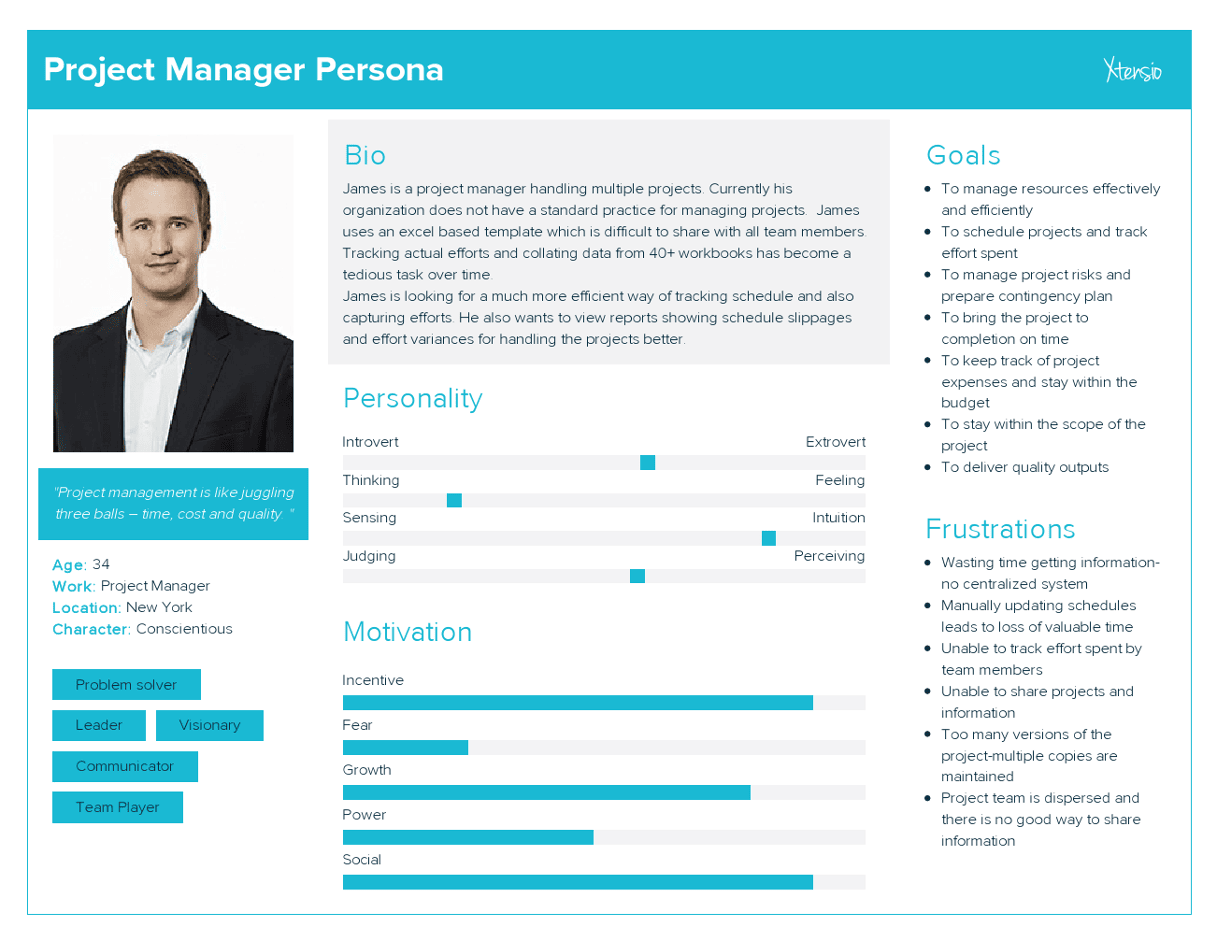User Persona: Why, How, Examples, and Free Template
Unlocking the secrets of your target audience is the key to successful marketing and business growth. But how well do you really know your customers? That's where the user persona technique comes in! This powerful tool allows business analysts to dive deep into the minds of their target market, helping them understand their needs, desires, and behaviors on a whole new level. In this blog post, we'll explore what exactly the user persona technique is, how it can assist business analysts in making informed decisions, its history, when and how to use it effectively, as well as its advantages and limitations. So, grab your detective hat because we're about to embark on an exciting journey into understanding our customers like never before!
What is the User Persona technique?
How the User Persona technique assists business analysts
History of User Persona Technique
When to use the User Persona technique
Advantages of the User Persona Technique
Limitations of the User Persona Technique
Common software used to develop User Personas
User Persona Worked Out Example
What is the User Persona technique?
The user persona technique is a powerful tool business analysts use to create fictional representations of their target audience. These personas are detailed profiles that encapsulate specific customer segments' characteristics, needs, motivations, and behaviors.
Essentially, user personas bring your customers to life! They go beyond basic demographic information and delve into aspects such as goals, pain points, preferences, and even personality traits. By creating these vivid characters, businesses gain a deeper understanding of who they're targeting and can tailor their products or services accordingly.
User personas assist in making informed decisions by providing insights into how customers think and behave. With this knowledge, business analysts can develop targeted marketing strategies that resonate with their audience on a more personal level. From product development to content creation and customer support initiatives - every aspect of the business benefits from having well-defined user personas.
So why is this technique so effective? It's because it allows businesses to step into their customers' shoes. By understanding their needs, desires, aspirations, challenges - everything that makes them tick - businesses can deliver solutions that truly meet those needs.
In summary (not concluding), the user persona technique helps businesses gain an intimate understanding of their target market through fictional character profiles. This invaluable tool empowers business analysts to make informed decisions based on deep insights into customer behavior patterns and preferences.
How Persona technique assists business analysts
The Persona technique is a valuable tool that assists business analysts in gaining a deeper understanding of their target audience. By creating detailed and realistic user personas, analysts can develop insights into their customers' needs, goals, and behaviors. This information enables them to make informed decisions about product development and marketing strategies.
One way the Persona technique helps business analysts is by providing them with a clear picture of who they are designing for. Analysts can easily visualize and empathize with their users by creating fictional characters representing different customer segments. This allows them to design products that meet specific needs and preferences.
Furthermore, the Persona technique helps business analysts prioritize features based on user requirements. By identifying which personas are most important to the success of their product or service, analysts can focus on developing features that cater to these specific individuals.
Another benefit of using the Persona technique is its ability to uncover hidden pain points or challenges faced by users. Through extensive research and interviews with real users, business analysts can gain insights into what frustrates customers or prevents them from achieving their goals. Armed with this knowledge, they can effectively design solutions that address these pain points.
In addition, the Persona technique assists business analysts in improving communication within cross-functional teams. By referring to personas during meetings or discussions, everyone involved gains a shared understanding of who they are targeting and why certain decisions have been made.
The Persona technique serves as an invaluable tool for business analysts to better understand their target audience's needs and preferences. It enables them to make data-driven decisions regarding product development while enhancing communication among team members throughout the process
History of Persona Technique
The history of the User Persona technique can be traced back to the 1980s when Alan Cooper, a software engineer and interaction designer, first introduced it. Cooper recognized the need for businesses to have a deeper understanding of their users in order to create more effective products and experiences.
Initially, personas were developed primarily for software design, but their usefulness quickly spread to other industries, such as marketing and business analysis.
Over time, the User Persona technique has evolved and become an integral part of user-centered design methodologies. It is now widely used by business analysts to gain insights into user behavior, preferences, goals, and pain points.
Various fields, including psychology, market research, and human-computer interaction, have influenced User persona development. As our understanding of user needs continues to grow and change, so too does the approach to creating accurate and realistic personas.
Today's business analysts rely on this technique as a valuable tool in their toolkit for gathering data-driven insights that inform decision-making processes across organizations. By developing well-defined personas based on real user data, they are able to tailor products and services specifically to meet customer needs.
In summary, the history of the User Persona technique dates back several decades, with its origins in software design. Since then, it has grown into a powerful tool used by business analysts across various industries.
It continues evolving alongside advancements in technology and remains an essential method for gaining deep insights into user behaviors, hopes, and challenges
When to use the User Persona technique
The persona technique is a powerful tool that can be utilized in various stages of business analysis. Here are some situations where using the persona technique can prove beneficial.
User Research: When conducting user research, developing personas can help gather valuable insights about target users. Businesses can tailor their products or services accordingly by understanding their needs, goals, and behaviors.
Requirements Gathering: During the requirements gathering phase, personas can provide a clear picture of end-users expectations and help define specific features or functionalities.
Decision Making: When making important decisions regarding product design, marketing strategies, or customer experience improvements, referring to well-defined personas ensures decisions align with users' preferences and desires.
Stakeholder Alignment: Personas act as a communication tool between stakeholders by providing a shared understanding of target users across teams and departments.
Testing and Validation: Personas serve as a reference point during usability testing sessions to evaluate if the product effectively meets the identified user needs.
Continuous Improvement: Throughout the development process, personas aid in prioritizing enhancements based on user feedback and evolving market trends.
By utilizing the persona technique in these scenarios, businesses can better understand their customers' wants and needs while driving informed decision-making processes for improved products and service delivery.
Advantages of the User Persona Technique
Improved understanding of target audience: One of the key advantages of using the User Persona technique is gaining a deeper understanding of your target audience. By creating detailed and realistic personas, you can identify their needs, goals, motivations, and pain points. This information helps business analysts tailor products or services to meet those specific needs.
Enhanced decision-making: User Personas provide valuable insights that can inform decision-making processes throughout a project's lifecycle. From design choices to marketing strategies, having a clear picture of your users' preferences and behaviors allows for more informed and targeted decisions.
Increased empathy: Developing User Personas requires research and analysis, which fosters empathy toward customers or users. Understanding their experiences and challenges enables businesses to create solutions that truly resonate with their target audience.
Effective communication: The use of personas facilitates effective communication among stakeholders involved in a project. It provides a shared language and reference point when discussing user requirements and expectations, ensuring everyone is on the same page.
Mitigation of assumptions: Using the User Persona technique helps eliminate assumptions about users by grounding decisions in real data rather than guesswork or personal biases. This leads to more accurate problem-solving approaches based on actual user needs.
Cost-effective strategy development: Creating user personas early in the planning phase helps save time, effort, and resources by focusing on features that align with user priorities instead of investing in unnecessary functionalities.
By leveraging the advantages offered by User Persona techniques during projects or product development cycles, Business Analysts gain invaluable insights into their target audience's mindset, saving both time and money and delivering better outcomes overall.
Limitations of the User Persona Technique
While the user persona technique is beneficial for business analysts, it does have its limitations. One limitation is that personas are based on assumptions and generalizations about user behavior. These assumptions may not always accurately reflect all users' true needs and behaviors.
Another limitation is that creating detailed and accurate personas can be time-consuming and resource-intensive. It requires extensive research, interviews, and data analysis to develop personas representing the target audience.
Additionally, user personas are static representations and may not account for changes in user behavior over time. As technology evolves and new trends emerge, user needs and preferences may shift, rendering existing personas outdated.
Furthermore, there is a risk of bias when developing personas. Business analysts must be careful to ensure that their own biases or preconceived notions do not influence the creation of personas. This can lead to inaccurate representations of the target audience.
Relying solely on user persona techniques may overlook important insights from other research methods, such as usability testing or A/B testing. While personas provide valuable information about users' goals and motivations, they should be used in conjunction with other research methods for a more comprehensive understanding.
Despite these limitations, the user persona technique remains a valuable tool for business analysts to understand their target audience better. By being aware of these limitations and using them in conjunction with other research methods, BABOK practitioners can overcome potential pitfalls while harnessing the power of this technique to inform decision-making processes effectively.
How to develop User Personas
User personas are essential for businesses to understand and connect with their target audience. Developing user personas involves a thorough understanding of the customers' needs, preferences, and behaviors. Here's a step-by-step guide on how to develop effective user personas.
1. Research: Start by gathering data through market research, customer surveys, interviews, and analytics tools. This will provide valuable insights into your target audience's demographics, motivations, goals, challenges, and pain points.
2. Identify patterns: Analyze the collected data to identify common characteristics that define different segments of your target audience. Look for similarities in age range, gender, occupation, interests, or hobbies.
3. Create profiles: Based on your research findings' identified patterns and traits, create fictional characters representing each segment of your target audience - these are your user personas.
4. Give them names: Personalize each persona by giving them a name that reflects their characteristics or role within the buying process.
5. Add details: Develop detailed profiles including information such as age range, job title/role (if applicable), background story/personal history related to their interaction with your product/service
6. Capture goals & challenges: Understand what motivates each persona and what obstacles they face when trying to achieve those goals while interacting with products/services like yours.
7. Visualize it all together: Use visuals such as images or illustrations along with written descriptions to bring these personas to life visually
8. Validate & Refine: Share the developed user personas with stakeholders, such as business analysts, testers, etc., to validate if they align well with actual customers/people who use similar services/products like ours. Further, refine based on feedback received during the testing phase.
Remember that developing user personas is an ongoing process; they should be continuously updated as you gain more insights about your target audience over time.
Common software used to develop User Personas
When it comes to developing user personas, several software tools can help business analysts streamline the process. These tools offer a range of features and capabilities, making it easier for analysts to create detailed and accurate personas.
One common software used by many professionals is UXPressia. This tool allows users to create visually appealing persona profiles with ease. It offers customizable templates and drag-and-drop functionality, allowing analysts to quickly add information such as demographics, goals, behaviors, and more.
Another popular option is Xtensio's, Persona Creator. With this tool, business analysts can build comprehensive personas by inputting data in pre-defined fields or creating their own custom sections. The software also provides collaboration features, allowing teams to work together on persona development.
Optimal Workshop's Reframer offers powerful research capabilities alongside persona development for those looking for a more advanced solution. It includes features like note-taking during interviews or observations and automatically generates insights from the collected data.
Miro is a versatile online whiteboard platform that can be utilized for various purposes, including creating user personas collaboratively. Its extensive library of templates and collaborative functionalities like sticky notes and comments section enables seamless teamwork in developing well-rounded user personas.
These are just a few examples of the software options available for developing user personas. Each tool has unique features and benefits — finding the right fit will depend on your specific needs as a business analyst!
User Persona Template
Developing user personas is crucial in understanding your target audience and creating effective marketing strategies. It allows you to create fictional characters that represent different types of users who might interact with your product or service. These personas help you gain insights into their needs, motivations, behaviors, and preferences.
A user persona template serves as a structured framework to guide the creation of these personas. It typically includes sections such as demographics, goals and objectives, challenges and pain points, preferred communication channels, and more.
Using a user persona template, business analysts can gather information from market research data, customer surveys, and interviews with stakeholders or customers. This information helps them create detailed profiles that accurately reflect the characteristics of various user segments.
The advantage of using a template is that it provides consistency across different personas while allowing room for customization based on specific industry or business requirements. It ensures that important details are not missed out during the persona creation process.
Common software tools like Adobe XD and Sketch offer pre-designed templates specifically tailored for creating user personas. These templates provide an intuitive interface where analysts can easily fill in the required fields and customize them according to their needs.
Having a well-defined user persona template makes it easier for business analysts to communicate valuable insights about their target audience with other team members or stakeholders involved in decision-making processes within an organization.
In conclusion, User persona templates are invaluable resources for business analysts looking to understand their target audience better. They provide structure and consistency in creating fictional characters that accurately represent real users' traits. By leveraging this technique, market research data, and stakeholder interviews, businesses can enhance their understanding of customer behavior patterns, leading to improved product development strategies aligned with users' needs.
User Persona Worked Out Example
The governance, Risk, and Compliance (GRC) management system is developed for the IT and ITES domain. The primary objective of the GRC management system is to help companies implement Governance, Quality, and Information Security Management Systems in an integrated manner. It has various features, one of which is to plan and track projects and programs using standards such as CMMI, ISO 9001, ISO 27001, etc.
Through this example, let us see the user persona of a project manager.

Conclusion
The User Persona technique is a valuable tool for business analysts to deeply understand their target users. By creating personas, they can empathize with their users and make informed decisions that align with their needs and goals.
Over time, the technique has evolved to become an essential part of the business analysis process. It helps bridge the gap between stakeholders and end-users, leading to more successful projects and products.
While there are some limitations to using User Personas, such as potential biases or outdated information, these can be mitigated through regular updates and validation with real user data.
Business analysts must conduct thorough research through interviews, surveys, analytics data, and other methods to develop an effective User persona. They should also consider using dedicated software tools like UXPressia or Xtensio that streamline the persona development process.
In conclusion, Business Analysts who incorporate the User Persona technique into their workflow will better understand their target audience's needs, pain points, and preferences.
This will ultimately lead to improved decision-making processes, resulting in more successful project outcomes.
Analysis done within the BABOK framework, based on accurate, user-centric insights gathered from well-developed personas, is bound to create value for businesses in today's competitive landscape.
So why not start applying this powerful technique today?
You May Also Like
These Related Stories

Why every BA must maintain a personal project retrospective?

Data Mining: History, Techniques, Advantages, and Examples





Comments (16)